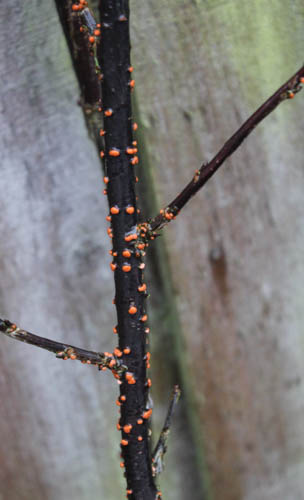
‘If the soil sticks to your shoes it is too wet’ but if conditions allow, now’s a good time to lightly fork over your flower borders, avoiding the crowns of perennials and emerging bulbs mixing in a layer of leaf mould or compost you go. This will improve the soil and relive compaction at the same time. Another option is to wait until spring, cover the soil with a 7.5cm layer of mulch and let the worms do the rest.
Rhubarb is a perennial garden favourite; easy to grow and very tasty. To get the best from your plants, divide and replant mature ‘crowns’ to keep your stock young and vigorous. Lift them carefully and cut them into sections with a bud using a sharp spade, then dig plenty of well-rotted manure or other organic matter into the planting hole and replant with the bud just above the surface. Keep it well watered and mulch around the plant then allow it to settle. Harvest a few stems after two years, then up to half the following years.
Towards the end of the month, prune your red and white currants to ensure a bumper crop this summer. Shorten the side shoots back to one bud and cut any old stems from the centre of the bush; cordons can be cut back to one bud too, and the leading shoot to two buds.
When planting a hedge, good ground preparation is the key to success. To make sure that they are healthy and vigorous for many years, dig the ground thoroughly, preferably two spades deep, adding plenty of well-rotted compost and removing any perennial weeds. After planting mulch around the hedge with well-rotted compost to give it the best possible start. Add mycorrhizal fungi to the planting holes according to the producer’s instructions.
Bull Finches are beautiful to look at but can be a real pest. Several times this winter, I’ve seen them nipping at the buds of my fruit trees. Normally they are happy to feast on grass and weed seeds, but when supplies run low, they turn their attention to plums, pears and cherry buds. Strangely, they usually leave apples and black currants until March and April and they don’t tend to like the buds of Morello cherries. It is a great argument for growing fruit in a cage or covering individual plants with netting. A 2cm mesh works well but should be lifted to allow access for pollenating insects later on in the year, when the plants are in flower.
The fungus ‘Coral Spot’ has appeared on some of my fruit cordons. The orange pustules of this fungus which are bright orange in the wet and paler and smaller in dry conditions are found on dead material and dying material and often indicate other problems with the plant like root damage or dieback. Prune out affected branches in dry weather back to the base at the ‘collar’ where the lateral shoot joins the main stem, well beyond outward signs of infection and feed plants in spring to keep them vigorous and healthy.
Happy gardening. Matt


